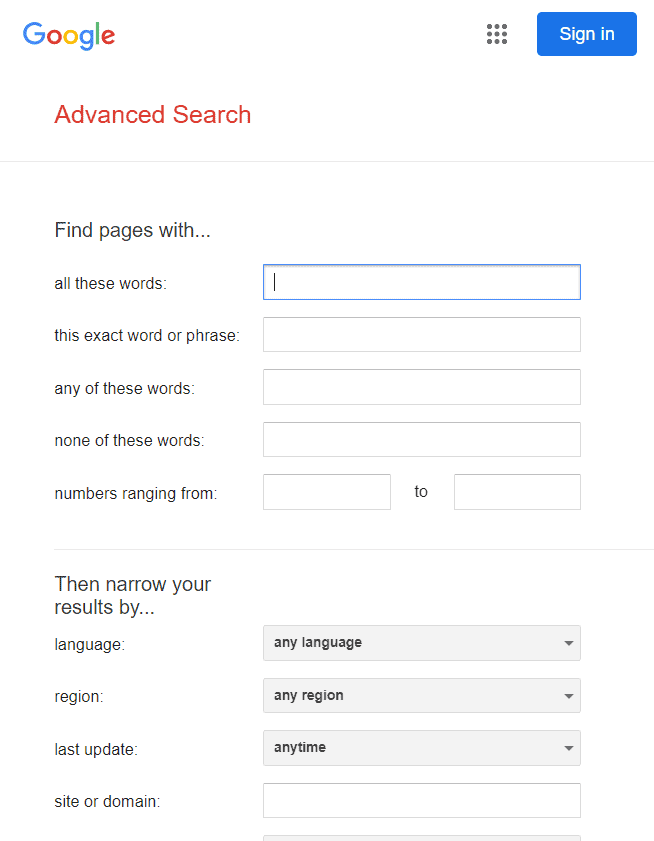Navigating the wealth of information available through Google searches can sometimes feel overwhelming. With millions of results generated in a matter of seconds, finding the specific content you need may be like searching for a needle in a haystack. However, Google has incorporated various features to help users refine their search results.
By learning to apply these useful filters and tools, individuals can tailor the search outcomes to meet their precise needs, whether they’re looking for a particular type of file, content from a specific time period, or resources from preferred domains.
Commands To Limit Search Results on Google
Google is the world’s most powerful search engine, but sometimes its results can feel overwhelming. That’s where search operators (commands) come in. These are special symbols and words you can type into Google to limit, refine, and control your search results.
Whether you’re a student, researcher, or just trying to find something specific, this guide will show you the most useful Google search commands.
🔍 Why Use Search Commands?
- Save time by avoiding irrelevant results.
- Get precise answers by narrowing searches.
- Find hidden resources like PDFs, old articles, or site-specific content.
- Do advanced research for SEO, academics, or fact-checking.
📘 Essential Google Search Commands
1. Exact Match
"your phrase here"
Searches for the exact phrase inside quotes.
👉 Example: "climate change report 2024"
2. Exclude a Word
keyword -word
Removes results containing the excluded word.
👉 Example: jaguar -car (finds the animal, not the car)
3. Site-Specific Search
site:domain.com keyword
Limits results to a specific site or domain.
👉 Example: site:nytimes.com elections
4. File Type Search
keyword filetype:pdf
Finds documents in a specific format (PDF, DOCX, PPT, etc.).
👉 Example: marketing strategy filetype:ppt
5. OR Search
keyword1 OR keyword2
Finds results containing either term.
👉 Example: vacation Italy OR Greece
6. Wildcard Search
"best * restaurants in Paris"
The asterisk (*) acts as a placeholder for unknown words.
👉 Example: "best * apps for students"
7. Search by Title
intitle:keyword
Shows pages with the keyword in the title.
👉 Example: intitle:"digital marketing"
8. Search by URL
inurl:keyword
Finds pages with the keyword in the URL.
👉 Example: inurl:resume developer
9. Before/After (Date Range)
keyword before:2023
keyword after:2022
Limits results to a specific time frame.
👉 Example: AI breakthroughs after:2024
10. Related Sites
related:website.com
Finds websites similar to the one entered.
👉 Example: related:amazon.com
11. Define a Word
define:word
Gives a direct dictionary definition.
👉 Example: define:serendipity
12. Cache View
cache:website.com
Shows Google’s last saved version of a page.
👉 Example: cache:bbc.com
🧩 Combining Commands
You can mix and match operators for even more precise results.
👉 Example:
"climate change" site:gov filetype:pdf after:2022
(Searches for government PDFs on climate change published after 2022.)
⚡ Quick Reference Cheat Sheet
" "→ Exact phrase-→ Exclude wordsite:→ Search within a sitefiletype:→ Find specific file typesOR→ Either word*→ Wildcardintitle:→ Keyword in titleinurl:→ Keyword in URLbefore:/after:→ Time filterrelated:→ Similar sitesdefine:→ Word definitioncache:→ Cached version
Final Thoughts
Google search commands are like shortcuts for power users. With just a few keystrokes, you can cut through the noise and find exactly what you’re looking for. Whether you’re hunting down academic papers, researching competitors, or troubleshooting tech issues, mastering these operators will save you time and frustration.
Popular Techniques To Filter Google Results
| Technique | How to Use | Example |
|---|---|---|
| Quotation Marks (” “) | Surround an exact phrase with quotation marks to find pages containing that specific wording. | "vegan lasagna recipes" |
| Minus Symbol (-) | Place a minus sign directly before a word to exclude results containing that term. | jaguar -car (Finds results about the animal, not the car company) |
| site: | Restrict results to a specific website or domain using site:. | healthy recipes site:mayoclinic.org |
| filetype: | Find specific file formats (like PDFs, Word Documents, etc.) by using filetype:. | resume templates filetype:pdf |
| Time Range (Tools) | After conducting a search, click “Tools” then “Any time” to choose a custom range (past hour, day, week, year, etc.) | Search: climate change -> Tools -> Any Time -> Custom Range (Select dates) |
Important Notes:
- You can combine multiple techniques for more refined searches. For example: “healthy desserts” -chocolate site:allrecipes.com
- Access more advanced search options by going directly to Google’s Advanced Search page: https://www.google.com/advanced_search
Understanding how to effectively limit search results can also enhance personal privacy and the relevance of the information retrieved. Instead of sifting through pages of unrelated or outdated material, using the right search parameters allows for a focused approach. This narrowed search is not only time-efficient but also ensures that the displayed information aligns closely with the query. Additionally, knowing how to filter results can avoid unwanted exposure to broad data, thus keeping one’s search more private and secure.
Google’s Advanced Search URL
https://www.google.com/advanced_search

Key Takeaways
- Google’s filter tools help sharpen search relevance.
- Limiting search results saves time and enhances privacy.
- Specific queries bring forth focused information.
Complete List Of Commands For Google Search
Basic Operators
| Operator | Function | Example |
|---|---|---|
" " | Searches for an exact phrase | "lasagna recipe" |
OR | Finds pages matching one term or another | vegan OR vegetarian recipes |
AND | Finds pages matching both terms | lasagna AND gluten-free |
- | Excludes a term from results | apple -fruit |
* | Wildcard, matches any word or phrase | best lasagna * in Italy |
Site-Specific and Filetype Operators
| Operator | Function | Example |
|---|---|---|
site: | Limits results to a specific site or domain | climate change site:nasa.gov |
filetype: | Searches for a specific file format | italian recipes filetype:pdf |
Other useful Operators
| Operator | Function | Example |
|---|---|---|
intitle: | Finds pages with the specified word in the title | intitle:lasagna recipe |
allintitle: | Finds pages with all specified words in the title | allintitle:best lasagna recipe |
define: | Provides a definition of a word | define:pesto |
cache: | Displays the most recent cached version of a page | cache:wikipedia.org/lasagna |
Important Notes
- Advanced Search Page: Google’s Advanced Search (https://www.google.com/advanced_search) offers even more options for refining searches.
- Combination: Combine operators for more precise searches (e.g., “vegetarian lasagna” site:bbcgoodfood.com filetype:pdf).
For a more comprehensive list, consider these resources:
- Kinsta Blog: Google Search Operators (https://kinsta.com/blog/google-search-operators/)
- Google Support: Refine web searches (https://support.google.com/websearch/answer/2466433?hl=en)
Utilizing Search Filters and Tools
Google Search offers a variety of filters and tools that help users narrow down their search results and find the information they seek quickly and accurately.
Adjusting Date and Time Filters
Google Search allows users to limit the results by date. Under the search bar, users can click on Tools and then select the desired time frame such as ‘Past hour’, ‘Past year’, or a custom date range. This is useful when searching for the most recent information or events from a specific period.
Refining Results with Specific Terms
Users can refine their search results by including specific phrases within quotes to find exact matches. Adding a minus sign before a word or site will exclude it from the search. For instance, including “-site.*” will filter out results from that particular domain.
Leveraging Domain and Site-Specific Searches
For focusing a search on a specific website or type of site, the site: operator becomes handy. By appending this operator to the domain such as site or .edu, users can limit searches to government or educational sites, respectively. To find a specific phrase within the title of a webpage, intitle: can be included before the search term.
Enhancing Privacy and Relevancy
In navigating Google’s search engine, users have tools at their disposal to manage their privacy and ensure their results are relevant to their queries. These settings can help filter unwanted content and safeguard personal information.
Managing Privacy Settings
SafeSearch: This is a helpful feature to filter explicit results like pornography or violent content. To activate SafeSearch:
- Go to your Google Account ID.
- Enter your password.
- Look for ‘Search settings’.
- Toggle SafeSearch to ‘On’.
Remember, this setting can be locked by guardians or administrators on school networks to prevent changes.
Privacy Controls: Regular audits of your privacy settings can protect your internet privacy.
- You can find these by going to the Search settings.
- Your search history can be reviewed and deleted here.
You may also set your history to auto-delete after a specific period (3, 18, or 36 months) in your Web & App Activity controls.

Seeking Quality and Relevant Content
Updated Search Function: Google continuously updates its search function to bring you the most relevant results. Keeping your keywords specific can help the search engine provide high-quality content that’s directly related to your search.
Using Time Filters: To further refine your search results:
- Use the ‘after:’ and ‘before:’ commands to set a time frame for your search.
- This feature is built into the search box for ease of use.
By regularly updating your privacy settings and knowing how to seek out quality, relevant content, your Google searches can become more secure and efficient.
Frequently Asked Questions
This section answers common inquiries about customizing Google Search to fit your needs, from changing the number of displayed results to filtering content by date.
How do I modify the number of results displayed per page on Google Search?
To change how many search outcomes you see per page, look for the settings link at the bottom of Google’s search page or in the top right corner, and find the option to adjust search settings.
What methods are available for narrowing Google search results to a specific site?
If you want results from one particular website, add the term site: followed by the website’s URL to your Google search. This will restrict search results to that specific domain.
Is it possible to filter out keywords in Google search results?
Indeed, to exclude certain keywords from your search, put a minus sign - directly before the word you wish to exclude without any space.
How can advanced search options be utilized to refine Google search queries?
Google’s advanced search page allows you to input various search criteria including specific phrases, excluding words, and choosing languages. You can access this by clicking on “Settings” and then “Advanced search” below the search box.
What steps can I take to exclude particular websites from my Google search results?
To avoid seeing outcomes from certain websites, just like filtering out keywords, put a minus sign - followed by the word site: and then the domain you want to exclude.
How can restrictions be applied to search results to only show content from a certain date range on Google?
You can specify a date range in your search query using the filters before: and after: followed by the date in the format YYYY-MM-DD. Alternatively, select “Tools” under the search bar and then “Any time” to choose a preset date range.






